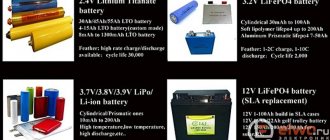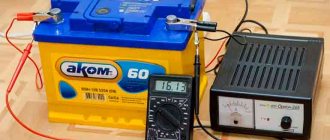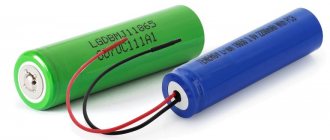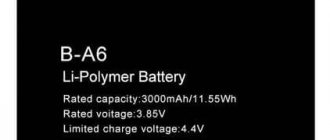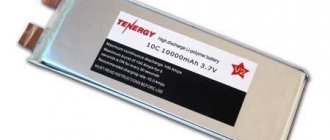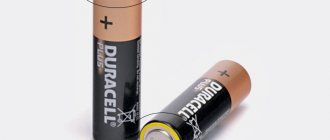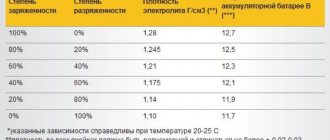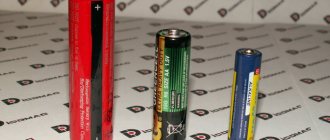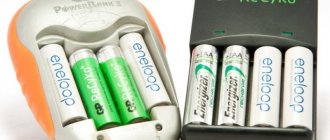How to properly charge a lithium-ion battery and significantly extend the life of 18650 batteries. What current should I use to charge a Li-Ion 18650 battery?
Batteries of this size have several important indicators:
- capacity (mAh – mAh)
- discharge current (A)
- charge current (A)
- maximum number of discharge cycles
In this article, I'll tell you about the last option and how this information can help you extend the life of your batteries.
TOP 3 headlamps with battery for indoor use
- The first symbol “I” is used on all elements of this type that are created using the same technology;
- The second letter allows you to understand what material the cathode is made of. For lithium-ion batteries, this can be cobalt - C, manganese - M, iron phosphate - F;
- The next letter – R – stands for battery;
- The 18650 numbers can be divided into two blocks: 18 and 65. These are the length and diameter, respectively;
- The last digit 0 is the shape, that is, the cylinder.
General characteristics of 18650
| Capacity (mAh) | Output voltage (V) | Maximum current (A) | Protection board |
| 1100 | 3.3 | +/- | |
| 1300 | 3.6 | 18 | +/- |
| 1620 | 3,6-3,7 | 20 | +/- |
| 2000 | 3,6-3,7 | 20-30 | +/- |
| 2100 | 3,6-3,7 | 20-30 | +/- |
| 2200 | 3,6-3,7 | 20-30 | +/- |
| 2400 | 3,6-3,7 | 20-30 | +/- |
| 2500 | 3,6-3,7 | 20-35 | +/- |
| 2600 | 3,6-3,7 | 20-35 | +/- |
| 2800 | 3,6-3,7 | 20-35 | +/- |
| 3000 | 3,6-3,7 | 20-35 | +/- |
| 3100 | 3,6-3,7 | 20-35 | +/- |
| 3200 | 3,6-3,7 | 20-35 | +/- |
| 3350 | 3,6-3,7 | 20-35 | +/- |
| 3400 | 3,6-3,7 | 20-35 | +/- |
| 3500 | 3,6-3,7 | 20-35 | +/- |
| 3600 | 3,6-3,7 | 20-35 | +/- |
The table shows the most popular batteries.
Dimensions with protection: 66.5*18 mm and 66*18 mm without protection. Weight on average about 40 grams.
Main manufacturers: Samsung, Fenix, Avant, LG, Panasonic, Olight, Camelion, Proconnect, Rombica, SANYO and SONY.
Homemade charger at home (with your own hands) - 1 circuit
To charge the 18650, purchase a universal charger and constantly use a multimeter to find out the necessary parameters. But such a device is quite expensive. Minimum price – 2700 rubles.
If the circuit is assembled correctly, there is no need for additional configuration - it will be immediately ready for use.
The positive point is that if you install the stabilizer on the desired radiator, then the battery is charged without fear that the charger will catch fire. But this certainly cannot be said about Chinese chargers, which suffer from this unpleasant consequence.
Step 2. How many batteries will we charge at the same time?
If the flashlight uses 4 batteries, then it is logical to purchase a charger that can charge 4 batteries at once. And if the flashlight is designed for 1 battery and we will carry the device with us in a backpack, then it is reasonable to take something more compact and lightweight. Most often, chargers with 1-6 slots are found on sale.
Expert opinion
It-Technology, Electrical power and electronics specialist
Ask questions to the “Specialist for modernization of energy generation systems”
Choosing a charger for an LED flashlight in 4 steps The service life of a lithium battery depends on operating conditions and is usually 2-3 years with a number of charge-discharge cycles of up to 600 for lithium-ion batteries and up to 900 for lithium-polymer batteries. Ask, I'm in touch!
Selecting the optimal charge current
Now let's discuss what current is best to charge 18650 batteries. Possible options are 0.5 A and 1 A. With a charging current of 1 A, the charging process is faster than at 0.5 A, but to preserve the service life of the batteries, a smooth charge is more preferable . Therefore, the optimal charging current is 0.5 A. If you need to speed up the charging process, you can increase the charging current to 1 A, but this should not be done unless absolutely necessary.
To recharge lithium batteries, it is advisable to use original chargers designed for use with a specific battery model. They clearly understand how much power a particular battery needs and stop the charging process in a timely manner. As for the current, the original chargers initially charge with a high current, and closer to the end of the charging process they reduce it. This algorithm helps to avoid overheating of batteries and extend their service life.
We invite you to read another educational material - about how to properly charge lithium iron phosphate batteries.
Go to the battery chargers section
How to charge a completely dead Li-ion 18650 battery?
If the 18650 lithium-ion battery has been in a discharged state for a long time, the voltage has dropped below the permissible limit, and the protective module has disconnected the battery from the terminals, the charger may refuse to charge such a battery. Perceiving low voltage as an emergency situation, it blocks the charging process. Therefore, a completely depleted Li-ion battery must be “push” - increase the voltage on it to 3.1–3.2 V.
You can take a mobile phone charger that produces a voltage of 5 V, and a 62 Ohm (0.5 W) resistor to limit the charging current. You need to connect them to the battery, attaching the wires to the terminals with neodymium magnets. Strong heating of the resistor indicates the presence of a short circuit inside.
If recharging does not start (the resistor does not heat up), there may be an internal break or the protection board is faulty. You can try removing the outer polymer shell and connecting the created charge to the jar, strictly observing the polarity. If the charge goes on, you need to wait until the voltage rises to 3.1–3.2 V and then use standard charging.
For those wishing to assemble a charger with their own hands, we suggest that you familiarize yourself with our previous article, which shows a diagram of a charger for Li-ion batteries.
What current can charge 21700?
For a very reasonable price, you get a charger with a 2A charging current, which will allow you to charge a 21700 battery as quickly as possible. And the less capacious 18650 Li-Ion battery will charge even faster. The charging current here will be only slightly more than the recommended 0.5, so you can take it easy and confidently charge.
Interesting materials:
Who was the mother of King David? Who was Yana Poplavskaya's husband? Who was the founder of the Golden Horde state? Who was the founder of the Turkic Kaganate? Who was the first appanage prince of the Moscow principality? Who was the last female pharaoh of the Ptolemaic dynasty? Who was the last khan of the Golden Horde? Who was the ruler of Phenicia? Who was the creator of the first manned spacecraft? Who were the Kipchaks?
How to choose the right 18650 battery for yourself
Lithium-ion batteries differ from each other in several characteristics. Because of this, it is necessary to pay attention to their type and technical characteristics before making a purchase.
When choosing a li ion 18650 battery, you need to pay attention to the following characteristics:
- Energy intensity;
- Rated current;
- Voltage
- Tendency to overheat.
If you need to purchase batteries with greater autonomy, then you need to pay attention to the capacity, which is measured in mAh. But, the higher the capacitance indicator, the lower the current will be. Therefore, by sacrificing one, you can gain another. In simple terms, the current strength affects the tendency of the battery to overheat.
The battery voltage depends on the charge. Voltage can be nominal, minimum, maximum and real. The manufacturer indicates the initial voltage on the packaging. It is important that its value does not fall below 2.4 Volts, otherwise the battery will be extremely difficult to revive. If you use batteries that do not withstand high temperatures well, you may experience an explosion.
Battery rating based on operating experience
What are PCB, BMS and PCM
Before we figure out how to properly charge lithium-ion batteries, let's understand the abbreviations PCB, BMS and PCM, which are inextricably linked with current sources of this type.
PCB
As we found out, lithium sources do not tolerate deep discharge and overcharge. In both cases, they catastrophically lose electrical capacity and fail. And if overcharged, they can even catch fire.
To monitor the condition of the battery, a PCB module - Power Control Board - is often built into it. Its task is to prevent deep discharge and overcharging of the battery.
The operating principle of such a module is quite simple. A controller placed on a small board monitors the voltage at the battery terminals. As soon as it drops below 2.8 V, the microcircuit closes the corresponding key, disconnecting the battery from the load. In this case, charging this element is allowed.
If the voltage at the terminals of the element becomes higher than 4.2 V (fully charged), the same circuit, using another key, disconnects the element from the charger, but power supply to the load is allowed. Thus, the battery can neither be recharged nor discharged to a critical value.
These protection boards are built into most lithium batteries. The only exceptions are elements intended for devices with their own battery monitoring systems. As an example, we can take a laptop battery assembled from six 18650 batteries without built-in protection.
Important! Before buying a battery, you need to find out whether it is equipped with a PCB module. If not, then you will have to monitor the condition of the element yourself. Most elements with a PCB module are marked accordingly on the case.
PCM
The PCM (Power Charge Module) is usually built not into the element, but into the device in which the element operates. For example, in a smartphone. If the PCB board only monitors the battery charge level, then the PCM unit completely controls the charging process - it provides the necessary current, controls the temperature of the element, and the voltage on it.
This is exactly the node that we call the charging controller. It is the main “controller” - it turns off charging when the battery is charged, and forcibly turns off the mobile device if the voltage on the battery is critically low. In this case, the PCB module will only be an additional protection - it almost never works. However, there are PCM modules that are only responsible for proper charging, but do not control discharge. In this case, the PCB module - built into the element or additional - is included in the work.
Expert opinion
Alexey Bartosh
Specialist in repair and maintenance of electrical equipment and industrial electronics.
Ask a Question
Important! The charging controller should not be confused with a charger (adapter) for the same smartphone. The charger is a regular five-volt power source. The battery charging process is controlled by a circuit built into the smartphone itself. The only exceptions are smart chargers designed specifically for charging lithium batteries (including those without a control module).
BMS
The BMS (Battery Monitoring System) unit can be found in batteries made up of batteries connected in series. It is, for example, in the battery of any laptop. The task of the unit is to monitor the condition of each individual battery and organize their coordinated work. Let's look at the task it performs in detail. So, we have a battery made up of four batteries connected in series.
Let's assume all cells are fully charged. The voltage on each of them is 4.2 V, on the entire battery 16.8 V. We begin discharging. The same discharge current flows through all elements, which means they are discharged equally. But this is only in theory. During operation, batteries lose capacity in different ways, that is, even with the same current, one element will discharge faster, the other more slowly. As a result, some of the batteries will already be deeply discharged, while the rest are still “pulling” and the output voltage of the entire battery seems to be normal.
The same will happen during charging. The element with the smallest capacity will charge faster and, while the others are gaining the required capacity, will overcharge and fail. The task of the BMS module is to monitor the condition of each element and take certain measures if the voltage on any of them becomes critical. If it is lower, the entire battery is disconnected from the load. If higher, then the corresponding element is disconnected from the charger while the others continue to charge.
Healthy! The BMS unit is often called a balancer, and the task it performs is called balancing. When connecting batteries in series into a battery, a balancing circuit must be present. Otherwise, the batteries will quickly fail and possibly even catch fire.

